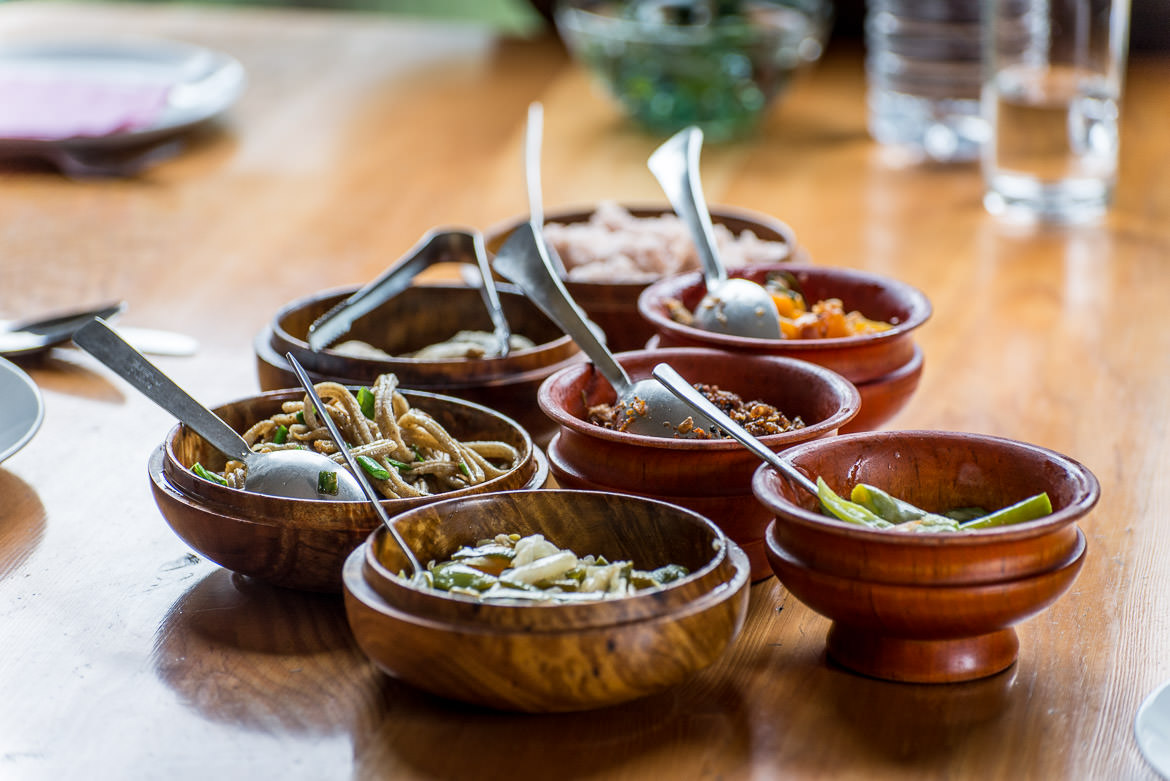Bhutanese Traditional Cuisine: Delight Your Taste Buds with Authentic Flavors

Table of Contents
Introduction to Bhutanese Traditional Cuisine
Bhutanese traditional cuisine is a culinary experience like no other. Rooted in history and deeply intertwined with Bhutanese culture, the food of this enchanting Himalayan kingdom is a delight for the senses. From its unique flavors to its vibrant presentation, Bhutanese food offers a journey into the heart and soul of the nation. In this article, we will explore the rich history and cultural significance of Bhutanese cuisine, discover traditional dishes and their ingredients, delve into the customs and etiquette of Bhutanese dining, and learn about the health benefits of these authentic culinary delights.
The History and Cultural Significance of Bhutanese Food
Bhutanese cuisine has a fascinating history that dates back centuries. Influenced by neighboring countries such as Tibet, India, and China, Bhutanese food has evolved into a distinct culinary heritage. Traditionally, the diet consisted mainly of red rice, buckwheat, maize, and barley, which were cultivated in the mountainous regions. These staple grains are still widely consumed today, forming the foundation of many Bhutanese dishes.
Food holds great cultural significance in Bhutan. It is not only a means of sustenance but also a way to celebrate life and connect with others. The act of sharing meals with family and friends is considered a sacred bond, fostering strong community ties. Bhutanese culinary traditions are deeply rooted in Buddhist principles, emphasizing simplicity, balance, and mindfulness. This reverence for food is evident in the meticulous preparation and presentation of each dish.
Traditional Dishes in Bhutan and Their Ingredients
Bhutanese cuisine boasts a diverse range of traditional dishes, each with its own unique blend of flavors and ingredients. Some of the most popular dishes include “Ema Datshi,” a spicy chili and cheese stew, “Doma,” a dish made from dried and fermented vegetables, and “Phaksha Paa,” a savory pork dish cooked with radish and greens. These dishes showcase the bold and robust flavors that are characteristic of Bhutanese food.
The ingredients used in Bhutanese cuisine are sourced locally and reflect the nation’s agricultural heritage. Fresh vegetables, such as spinach, radishes, and mushrooms, are abundant in Bhutan and feature prominently in many dishes. Dairy products, particularly cheese and butter, are also integral to Bhutanese cooking. Yak meat, pork, and poultry are commonly used in meat-based dishes, while chili peppers and various spices add a fiery kick to the cuisine.
Bhutanese Food Specialties and Their Unique Flavors
Bhutanese food specialties offer a taste of the country’s distinct flavors and culinary heritage. “Momos” are one such specialty, which are steamed dumplings filled with meat or vegetables. These bite-sized delights are a favorite among locals and visitors alike. Another specialty is “Zow Shungo,” a dish made from leftover rice cooked with vegetables and cheese. It is a simple yet flavorful meal that exemplifies Bhutanese resourcefulness.
The unique flavors of Bhutanese cuisine are a result of the careful balance of spices and ingredients. Sichuan pepper, garlic, ginger, and turmeric are commonly used to enhance the taste of dishes. Fermented condiments, such as “ezay” (a chili paste) and “sikam” (a dried pork condiment), add depth and complexity to the flavors. The use of chili peppers gives Bhutanese food its signature spiciness, which is tempered by the richness of dairy products like cheese and butter.
Traditional Bhutanese Dining Customs and Etiquette
Bhutanese dining customs and etiquette play a significant role in the overall dining experience. Meals are often enjoyed in a communal setting, with everyone seated on the floor around a low table. It is customary to eat with your hands, using your right hand to pick up food. The meal typically begins with a simple prayer, expressing gratitude for the food and the opportunity to share it with others.
Hospitality is highly valued in Bhutanese culture, and guests are treated with utmost respect. It is considered impolite to decline food or drink offered by the host, as it is a gesture of goodwill. Taking small portions and finishing what is on your plate is a sign of appreciation. Burping is considered a compliment to the host, indicating that the meal was enjoyed. These customs reflect the warmth and hospitality that Bhutanese people extend to visitors.
Must-Try Bhutanese Dishes for Food Enthusiasts
For food enthusiasts, Bhutan offers a plethora of must-try dishes that showcase the diverse flavors of the country. “Kewa Datshi” is a popular dish made from potatoes and cheese, cooked in a spicy chili sauce. The combination of creamy cheese and fiery chilies creates a tantalizing taste experience. “Jasha Maru” is another dish worth trying, featuring tender chicken cooked with onions, tomatoes, and spices. The flavors are robust and comforting, making it a favorite among locals.
If you are feeling adventurous, “Bumthang Swiss Cheese” is a unique Bhutanese specialty that blends traditional Bhutanese cheese-making techniques with Swiss methods. The result is a creamy and flavorful cheese that can be enjoyed on its own or incorporated into various dishes. Whether you prefer vegetarian or meat-based dishes, Bhutanese cuisine offers an array of options to satisfy every palate.
Regional Dishes in Bhutan and Their Distinct Characteristics
Bhutan’s regional dishes showcase the diversity of flavors and ingredients found throughout the country. In the western region, “Hoentoe” is a popular dish made from buckwheat dough filled with spinach, cheese, and turnip greens. It is a labor-intensive dish that requires skill and precision to make. In the central region, “Khuli” is a traditional dish made from maize, cheese, and vegetables. It is often served with “puta,” a traditional Bhutanese flatbread.
In the eastern region of Bhutan, “Shakam Paa” is a dish that highlights the use of dried and smoked meat. It is cooked with radishes, chili peppers, and spices, resulting in a hearty and flavorful dish. Each regional dish has its own distinct characteristics, reflecting the local ingredients and culinary traditions of the area. Exploring these regional specialties is a fascinating way to delve deeper into the culinary landscape of Bhutan.
Bhutanese Street Food and Local Flavors
Bhutanese street food offers a vibrant and dynamic culinary experience. The streets of Bhutan come alive with the aroma of sizzling snacks and the hustle and bustle of food vendors. “Phaksha Paa” is a popular street food dish, featuring succulent pieces of pork cooked with chili peppers and radishes. It is a spicy and satisfying snack that is perfect for on-the-go.
Another popular street food is “Gondoay Datsi,” which is a deep-fried cheese snack served with a spicy tomato sauce. The crispy exterior and gooey cheese center make it a delightful treat. “Jaju” is a sweet street food that is made from rice flour and deep-fried until golden brown. It is often enjoyed with a cup of butter tea, a traditional Bhutanese beverage. Exploring the vibrant street food scene allows you to immerse yourself in the local flavors of Bhutan.
Bhutanese Culinary Traditions and Their Preservation
Preserving Bhutanese culinary traditions is of utmost importance to the nation. The Bhutanese government has implemented measures to protect and promote traditional Bhutanese cuisine. The Bhutanese Culinary Heritage Preservation Program aims to document and preserve traditional recipes, cooking techniques, and cultural practices associated with food.
Local communities play a vital role in the preservation of culinary traditions. They pass down ancestral knowledge and techniques from one generation to the next. Traditional cooking methods, such as using open fires and clay pots, are still practiced in many households. The commitment to preserving Bhutanese culinary traditions ensures that future generations can continue to enjoy the authentic flavors of the land of the Thunder Dragon.
Famous Bhutanese Dishes that Have Gained International Recognition
Bhutanese cuisine has gained international recognition for its unique flavors and cultural significance. One such dish is “Ema Datshi,” which is often considered the national dish of Bhutan. It has gained popularity beyond the borders of the country and is now enjoyed by food enthusiasts worldwide. The combination of spicy chilies and melted cheese in “Ema Datshi” is a culinary delight that has captivated taste buds around the globe.
Another dish that has gained international acclaim is “Suja,” a traditional Bhutanese butter tea. This hot beverage, made from tea leaves, yak butter, and salt, is a staple in Bhutanese households. The distinct flavors and creamy texture of “Suja” have made it a sought-after drink among tea connoisseurs worldwide. These famous Bhutanese dishes have become ambassadors of Bhutanese cuisine, introducing the world to the unique flavors and culinary traditions of the country.
Authentic Bhutanese Recipes for Home Cooking
Bringing the flavors of Bhutanese cuisine into your own kitchen is a rewarding experience. Authentic Bhutanese recipes allow you to recreate the vibrant flavors of the land of the Thunder Dragon in the comfort of your home. “Kewa Datshi” is a simple yet delicious recipe that combines potatoes, cheese, and chilies. It can be served as a main dish or as a side to complement other Bhutanese delicacies.
For a hearty and wholesome meal, “Phaksha Paa” is a recipe worth trying. This pork dish is cooked with radishes and chili peppers, resulting in a flavorful and comforting dish. “Ezay” is a condiment that is often enjoyed alongside Bhutanese meals. Made from chili peppers, onions, and spices, it adds a burst of flavor and heat to any dish. Exploring authentic Bhutanese recipes allows you to embark on a culinary adventure and discover the magic of Bhutanese flavors.
Exploring the Bhutanese Food Culture Through Local Markets and Restaurants
To truly immerse yourself in the Bhutanese food culture, a visit to local markets and restaurants is a must. The markets of Bhutan offer a glimpse into the vibrant array of fresh produce, spices, and condiments that are integral to Bhutanese cuisine. From colorful vegetables to aromatic spices, the markets are a feast for the senses.
Local restaurants provide an opportunity to savor authentic Bhutanese meals prepared by skilled chefs. The cozy ambiance and warm hospitality of these establishments create a memorable dining experience. Whether you choose to sample traditional dishes or try innovative interpretations of Bhutanese cuisine, dining in local restaurants allows you to fully appreciate the flavors and culinary traditions of Bhutan.
Bhutanese Culinary Delights and Their Health Benefits
Bhutanese culinary delights not only offer a tantalizing taste experience but also provide numerous health benefits. The use of fresh and locally sourced ingredients ensures that Bhutanese dishes are packed with nutrients. The abundance of vegetables in Bhutanese cuisine contributes to a well-balanced diet rich in vitamins and minerals.
Turmeric, a common spice in Bhutanese cooking, is known for its anti-inflammatory properties. It is believed to have numerous health benefits, including boosting the immune system and improving digestion. The consumption of dairy products, such as cheese and butter, provides a good source of calcium and protein. The incorporation of whole grains, such as red rice and buckwheat, adds fiber and essential nutrients to meals. Embracing the flavors of Bhutanese traditional cuisine not only satisfies your taste buds but also nourishes your body.
Embrace the Flavors of Bhutanese Traditional Cuisine
Bhutanese traditional cuisine is a culinary journey that delights the senses and nourishes the soul. From the rich history and cultural significance of Bhutanese food to the vibrant flavors and unique ingredients, every aspect of Bhutanese cuisine tells a story. By embracing the flavors of Bhutanese traditional cuisine, you embark on a gastronomic adventure that connects you to the land of the Thunder Dragon.
Whether you choose to try traditional Bhutanese dishes in local restaurants, explore the regional specialties, or experiment with authentic Bhutanese recipes at home, each bite brings you closer to the heart of Bhutan. Let the flavors of Bhutanese cuisine transport you to a world of authenticity and tradition, where food is not just sustenance but a celebration of life itself.
Experience the magic of Bhutanese cuisine by trying out a traditional Bhutanese recipe today. Let your taste buds savor the authentic flavors of the land of the Thunder Dragon and embark on a culinary adventure like no other.

